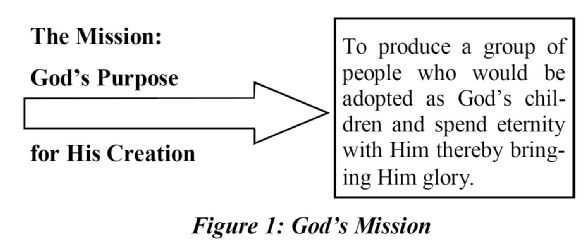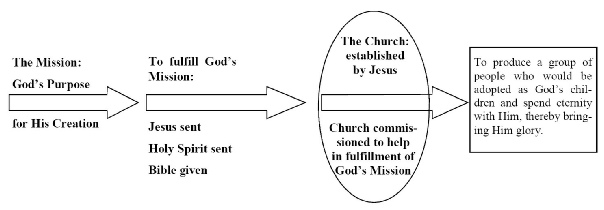
A Framework for Understanding
the Development of Church Leaders
by John M. Elliott
Training leaders for the church is a challenging task, which cannot be considered in isolation by itself. Everywhere in the world the church exists in specific cultural contexts that have affected the church in a myriad of ways, including its understanding of itself. This subtab seeks to establish a framework in which the task of developing church leaders can be understood.
Part 1 considers the nature of the Church and its mission, as given to it by God and recorded in the Bible.
Part 2 goes on to look at the effects culture and tradition play in the unfolding of the Church's mission in a particular context.
Part 3 expands on this by considering how an individual local church can fulfill the Great Commission and "make disciples in all nations."
Part 4 concludes with a brief historical overview of how the Church has understood itself and its mission over the past 2000 years.
Part 1.
Begin with a Biblical Understanding
of the Church and Its Mission.
Most Christians come to know Christ in a particular church and over time absorb that local church's views without questioning them. Such basic questions as, “Is there a biblical model for what a local church should look like and be doing?” are rarely asked. People merely assume that the church they know and have been exposed to is the only way to organize a church, and all other churches have in some way “departed from the truth.” Those who look into the matter will learn that over the past two thousand years there have been widely differing views on what the Church is all about. This variety of understandings concerning the nature and mission of the church has played a key role the development of the wide variety of denominations in the world today.
While defining the nature of the Church and its mission seems rather basic and is rarely discussed, it is crucial to one's understanding of local church leadership. The primary function of church leadership should be to assist the church in fulfilling its God-given role in the world. Therefore the church's understanding of itself and its mission will determine the nature of leadership that the church needs, which will in turn be an important factor in determining how those leaders are trained. If the church needs leaders who can carry the gospel into remote rural areas, the training needed will be very different from that required of leaders who are to pastor churches in the capital city geared to reach government and business people. A new church planted in an unevangelized people group needs a different kind of leader than a church located in a well-evangelized community in which almost everyone considers themselves to be a Christian.
As most people read the Bible, they unconsciously read it from where they stand, situated within a certain church context. They tend to see in the Bible what they expect to see and what they have been taught to see. This next section is an attempt to present what the Bible teaches concerning the Church and its mission in a summary fashion and hopefully will stimulate your thinking on this important issue.
1. God's Mission. God's ultimate purpose in creating the world was to bring glory to Himself by producing a group of people who would choose to spend eternity with Him. God predetermined to adopt these people as His children and thus become a part of God's family. The Bible declares this to be God’s Mission, the goal of His work in creation.
Genesis 1. Man created in God's image, the only being on earth so created.
Ephesians 1:4-5. God's purpose, before the world was created, was that we should be holy and blameless, adopted as sons of God.
Revelations 5:9-10 and 7:9-10. In the end, people from every tribe and nation are pictured as enjoying God's presence in heaven. They will be a people over whom God will reign. They will serve God as priests and they will reign with God on the earth.
2. God's Plan to Achieve His Goal. To achieve this product, God created man with a free will—the ability to choose whether to serve God or not. God did this knowing that man would choose to sin, thereby destroying man's original state of fellowship with God (Genesis 3). God planned in advance to send his Son, Jesus, so that forgiveness of sins and restoration of the relationship broken by man's sin could be offered freely to all who desired it (John 3:16; Ephesians 1:4-5; 2:8-10). In order to prepare for the coming of His Son, God established a covenant with Abraham and his descendants, the nation of Israel, and promised that through Abraham all nations on earth will be blessed (Genesis 12:3). In time God revealed that someone called the Messiah would come, one who would be a son of David (Isaiah 11:1-5) and yet would be called the Mighty God (Isaiah 9:6). At the right time Jesus, the Son of God, was born into the world. After achieving all that the Father had sent Him to do, Jesus was crucified in Jerusalem and thereby secured the possibility for all of mankind to be forgiven for their sins. But only those who by faith received Jesus Christ as their Savior and Lord are forgiven. Those who are forgiven are declared to be righteous in God's sight and are adopted as God's children. They become the “called out ones,” or the church.
For this plan to be implemented, mankind must know of God's provision. How was the plan is to be made known to the peoples of the earth? God's plan called for the use of the church, those who had already received forgiveness of sins and eternal life, to become the carriers of the message. Thus, God has commissioned all those who have experienced his love and forgiveness to bear witness concerning this plan to those who have not yet heard.
3. Jesus Establishes the Church. Part of Jesus' mission was announced to be the establishment of the Church (Matthew 16:18). While on earth, Jesus surrounded Himself with a band of disciples who heard His teachings and watched Him put them into practice. These disciples sought to imitate their Master by living lives in conformity to His teachings. After dying for the sins of mankind and then appearing to His disciples to assure them that all which was taking place was in accord with God's plan, Jesus commissioned His disciples to spread the good news of God's plan to all peoples and make disciples of all nations (Matthew 28:19-20). The church was not left alone to accomplish this plan. Upon His return to the Father, Jesus sent the Holy Spirit to direct and enable His followers in the fulfillment of God's plan (Acts 1:8).

Over the next few decades the Church developed from one small band of disciples in Jerusalem to hundreds of small bands of believers scattered across the eastern half of the Roman Empire and beyond. The New Testament gives us glimpses of this development, though it does not give us every detail.
4. The Nature of the Church. The English word “church” is used to translate the Greek word “ecclesia.” The basic meaning of the word is “the called-out ones.” The picture is of a group of people who have been called out of the peoples of this world by God to form a new group. The word is used in two contexts. First, it is used of all true believers, no matter where they live or when they live (Ephesians 1:20-23; Hebrews 12:23. Second, it is used of a local group of believers who meet together regularly for worship and fellowship (Acts 20:28; 1 Corinthians 1:2; Colossians 4:15). The word “church” is never used in the Bible to refer to a building, to a denomination, or to a worship service. It is only used to refer to people. Thus, when Christians today use the word “church” to refer to anything other than a group of Christian believers, they are reflecting the fact that their understanding of the nature of the church has been affected by later developments of church history. The New Testament further describes the Church as the body of Christ with Jesus as the head. All believers, including church leaders, are parts of this body, equipped with certain spiritual gifts by the Holy Spirit for the common good.
5. The Mission of the Church. God has commissioned the Church to join Him in His mission—gathering a group of people who desire to become God's children and spend eternity with Him. Local groups of believers become co-laborers with Christ in finding the lost, sharing the good news with them, and incorporating those who respond into either new or existing local churches. The Church is therefore both the goal of God's mission and also the agent through whom the mission is being accomplished. This dual concept has frequently caused problems in understanding the nature and mission of the Church. Is the church the goal of God's mission or is it the agency through who God is seeking to fulfill His mission? The answer is both! When the church has focused only on the passive aspects of God's mission and sees itself as the recipient of the works of God, it stops becoming a missionary-minded church and further expansion of the church is halted. But when God's people realize that they are both the recipients of God's work and also the one's through whom God wants to work in reaching others around the world, they have a proper understanding of the Church and its mission.
Summary
In summary, God's plan in creating this world was to produce a family of adopted sons and daughters who would spend eternity with him. Jesus came to the earth and died for our sins, making it possible for those who wished to become children of God. The future heavenly family of God is a body of people who are known as the “called-out ones,” or the Church. It is represented on earth by those still living who have chosen to accept God's offer of forgiveness of sins and adoption as his sons and daughters. These believers are to gather themselves into local churches for certain purposes set out in the Bible, with the goal of sharing the good news with the rest of mankind and incorporating those who respond into local churches. The Father and the Son have sent the Holy Spirit to direct and enable the church to carry out God's Mission in the world today.



